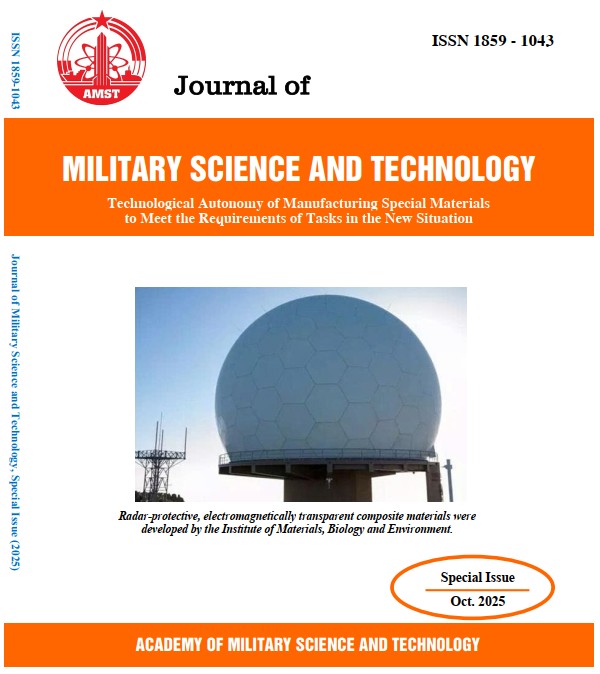Preparation of hydroxyl-terminated polybutadiene via oxidation-reduction method using alcohol catalysts
DOI:
https://doi.org/10.54939/1859-1043.j.mst.IMBE.2025.70-75Keywords:
Hydroxyl-terminated polybutadiene (HTPB); Alcohol catalyst; Sodium borohydride reduction.Abstract
Conventional methods for synthesizing hydroxyl-terminated polybutadiene (HTPB) with high cis-1,4 content typically involve multi-step oxidation-reduction processes, hindered by poor solubility of sodium borohydride in low-polarity solvents, resulting in low efficiency during the reduction of aldehyde-terminated polybutadiene. A one-pot synthesis approach that incorporates alcohol catalysts to enhance reduction performance is presented in this study. The study results show that ethanol significantly improved reduction efficiency, achieving near-complete conversion of carbonyl to hydroxyl groups within 15 minutes at 30 oC. The resulting HTPB possessed a cis-1,4 content of approximately 95%, with a molecular weight of ~4,880 g.mol-1, a hydroxyl value of 0.78 mmol.g-1 and a glass transition temperature of Tg = -92.1 oC.
References
[1]. L. T. DeLuca et al., “Characterization of HTPB-based solid fuel formulations: Performance, mechanical properties, and pollution”, Acta Astronautica, 92(2), pp. 150–162, (2013).
[2]. V. Sekkar et al., “Pot life extension of hydroxyl terminated polybutadiene based solid propellant binder system by tailoring the binder polymer microstructure”, Journal of Macromolecular Science, Part A, 54(3), pp. 171–175, (2017).
[3]. Q. Zhou et al., “Preparation of Hydroxyl-Terminated Polybutadiene with High Cis-1,4 Content”, Industrial & Engineering Chemistry Research, 53(46), pp. 17884–17893, (2014).
[4]. J. C. Brosse et al., “Hydroxyl-terminated polymers obtained by free radical polymerization - Synthesis, characterization, and applications”, in Catalytical and Radical Polymerization, Springer Berlin Heidelberg, pp. 167–223, (1986).
[5]. J.-m. Chen et al., “Synthesis of hydroxyl-terminated polybutadiene possessing high content of 1,4-units via anionic polymerization”, Chinese Journal of Polymer Science, 28(5), pp. 715–720, (2010).
[6]. D. Meng et al., “Preparation of Hydroxyl-Terminated Polybutadiene by the Pyrolysis Method and Its Application in Polyurethane”, ACS Applied Polymer Materials, 6(14), pp. 8235–8243, (2024).
[7]. K. Tanemura, “Reduction of aldehydes and ketones by a stoichiometric amount of NaBH₄ using a small amount of MeOH or EtOH”, Results in Chemistry, 4, p. 100486, (2022).
[8]. K. Ramya et al., “Hydrogen production by alcoholysis of sodium borohydride”, International Journal of Energy Research, 37(14), pp. 1889–1895, (2013).
[9]. H. C. Brown et al., “A Study of Solvents for Sodium Borohydride and the Effect of Solvent and the Metal Ion on Borohydride Reductions”, Journal of the American Chemical Society, 77(23), pp. 6209–6213, (1955).
[10]. Y. Tanaka et al., “Characterization of diene polymers. I. Infrared and NMR studies: Nonadditive behavior of characteristic infrared bands”, Journal of Polymer Science Part A-2: Polymer Physics, 9(1), pp. 43–57, (1971).
[11]. D. Papp et al., “A Complementary Multitechnique Approach to Assess the Bias in Molecular Weight Determination of Lignin by Derivatization-Free Gel Permeation Chromatography”, Analytical Chemistry, 96(26), pp. 10612–10619, (2024).







